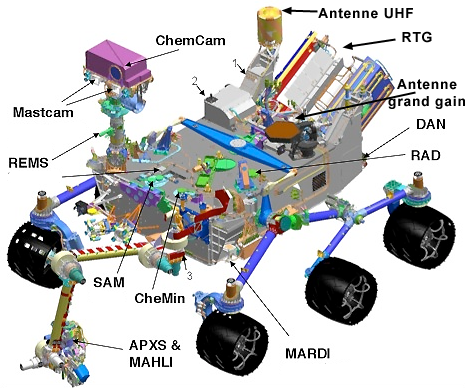Yesterday evening, the Mars Science Laboratory’s Curiosity Rover successfully touched down on the surface of Mars and sent its first pictures back to mission control.
The rover — at almost 900 KG, the heaviest object yet sent to Mars — was lowered by sky-crane onto the surface of the Aeolis Palus region of the Gale Crater. From there it will travel to the 3-mile high Aeolus Mons mountain at the center of the crater to explore and carry out scientific analysis of its environment.
After its long journey to our neighboring planet, the rover entered the Martian atmosphere encased in an aeroshell, and, following thruster-powered breaking, deployed the largest supersonic parachute ever made, which slowed the rover’s descent to about 200 miles per hour. At this point, Curiosity separated from its aeroshell and began a powered descent, after which it was deployed beneath a rocet-powered platform (the sky crane), which reduced the rover’s speed, before gently lowering it on wires to the surface. It was the first time this method of landing had ever been used. The rover was too heavy to rely on the usual parachute and air-bag method.

The Curiosity Rover — whose name was chosen by sixth-grade elementary school student Clara Ma — is powered by nuclear batteries and is expected to remain functional for about two years. The rover’s operations will be controlled by its two identical on-board computers, each of which includes 256 KB of EEPROM memory, 256 MB of DRAM, and 2 GB of flash memory on a RAD750 single-board computer, which incorporates a PowerPC 750 CPU (aka PPC G3) capable of 400 MIPS.
Curiosity carries the most comprehensive science package ever sent to Mars. In addition to a plethora of cameras and environmental sensors, one of the most impressive instruments Curiosity has at its disposal is the ChemCam, which incorporates a laser able to vaporize rock samples at 23 feet so that they can be analyzed by a spectrograph to discover their composition and chemistry.
While Curiosity is able to phone home directly using its X band transmitter, most communications with Earth will take place via the Mars orbiters, using a UHF software-defined radio.
The mission is designed to discover new information about the geology and climate of Mars, including whether water is present on or under the surface. The most exciting aspect of Curiosity’s mission is that much of the gathered data will be used in the planning of a future manned mission to Mars.
We at NYI offer our congratulations to NASA for this wonderful achievement, and will be eagerly watching the news of this intrepid explorer’s investigations.
Related articles




